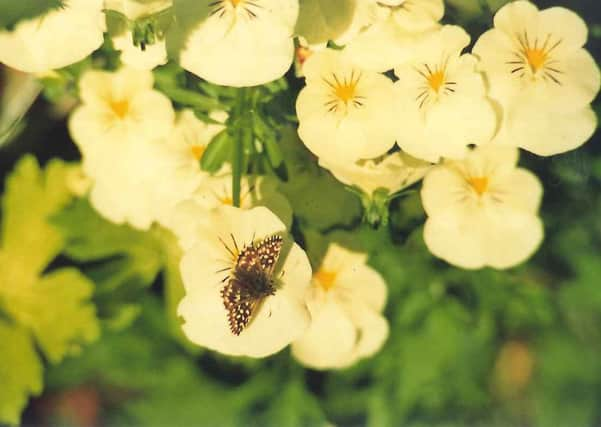RICHARD WILLIAMSON: Unwholesome appetites of the garden butterfly


Take for instance that little gem, the grizzled skipper. Here it is in my garden feeding on a pansy. How sweet.
The very next day I saw six of them. They were feeding on a dead fox. Not in my garden this time, but way up on the Downs. They were so sated on the rotting (very smelly) flesh, they could almost be touched. Unfortunately I hadn’t taken my camera with me.
Advertisement
Hide AdAdvertisement
Hide AdCome Dine With Me is one of the articles in The Sussex Butterfly Report for 2012, which gives stories, reports, photographs, and outdoor field events you can attend for 2013. Mark Colvin, the editor, also gives the low-down on the filthy habits of our best-loved insects.
Even in the flying stage they need more than just nectar from flowers. This is merely the petrol in the engine. All sorts of other nutrients are needed to maintain the body.
His photograph shows a pair of our most delicate and elusive varieties, the wood white, imbibing horse dung. Perhaps you have seen as you wander the bridleways of the downs, a red admiral doing the same on one of these cushions of brown ammonia.
That great character and naturalist, Major Bill Phillips, when he was alive, always wore his trilby when out in the Sussex countryside hunting for birds, orchids, butterflies and beetles to photograph. The hat was old and dusty, with the rim stained by sweat from when he had searched for small mammals in the Punjab and Ceylon. Often I have seen a comma or red admiral butterfly perching on his head as their long proboscis uncurled and sipped the sodium.
Advertisement
Hide AdAdvertisement
Hide AdEvery year in my garden, a purple emperor comes on to my sandal for the same precious nutrient when the insect emerges in July.
Often I have photographed this depraved habit of theirs. They also love horse dung – or any filth they might come across. Tarry deposits also attract them.
Mark describes the act of ‘puddling’ – common to butterflies all over the world. The fermenting juices from dead fish, urine, rotting fruit, tree sap, animal carcases, bird droppings, even wet embers from fires, all provide trace elements the insect must have to function correctly. Scientists think this is mainly a need for sodium. Nitrogenous and potassium-rich wastes are wanted as well.
Sodium may be needed to assist amino-acid digestion and neuromuscular processes.
Advertisement
Hide AdAdvertisement
Hide AdMale butterflies probably need trace elements to build up their sperm counts.
Mark wonders whether eating such odd nutrients is the entomological equivalent for men drinking a can of Red Bull.
But whatever attracts purple emperor butterflies on to my flesh is something enjoyed by both male and female of that species.
They only try me once though – and that is on the day they emerge as adult flying insects. After that first five minutes of puddling me, they have had enough, and never come back for more.
Either whatever they are getting off me is very potent or it is just too horrid for these delicate insects. But at least the colony has continued here – so my trace elements can’t be too lethal.